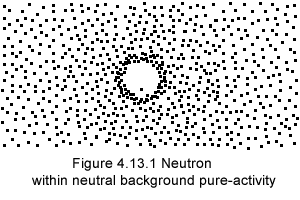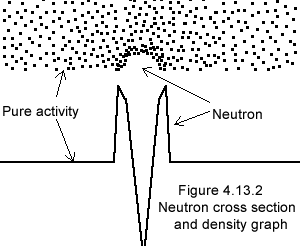Neutrons (§4.13)
 A neutron in gravimotion is made of an incompatible proton/electron pair which incompatibilities are perfectly counter-matched, ending up in a complete merger while maintaining integrity.
A neutron in gravimotion is made of an incompatible proton/electron pair which incompatibilities are perfectly counter-matched, ending up in a complete merger while maintaining integrity. A neutron, as an atom of hydrogen conciliates the 2 incompatible proton and electron, but the electron succeeded in reaching the summit of the proton heap, cancelling at same time all surrounding graded activity, and appearing neutral from the outside. A neutron occupies a much smaller volume of pure activity than an atom does.
A neutron, as an atom of hydrogen conciliates the 2 incompatible proton and electron, but the electron succeeded in reaching the summit of the proton heap, cancelling at same time all surrounding graded activity, and appearing neutral from the outside. A neutron occupies a much smaller volume of pure activity than an atom does.A neutron, when free in pure activity as shown in figure 4.13.1, decays into a proton an electron and a neutrino. The neutrino is a particle introduced in physics mathematics. It is necessary to balance out the energies measured in the experiments. The opposite motions that maintain the cohesion of a neutron in gravimotion might be coincidental to physics neutrino.
The neutron may also be bonded to the nucleus of an atom, through the strong-activity (§4.5), which is radial in gravimotion; when a neutron is bonded to the nucleus of an atom its decay becomes practically forbidden.